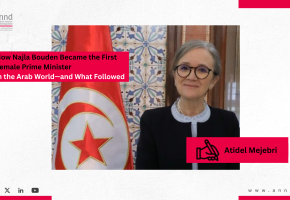Women’s Participation in the Labor Force in the Arab Region: A Critical Reading of the Role of the IMF – Hassan Sherry
"If you exclude 50% of the talent pool, it is no surprise that you find yourself in a war for talent."
In recent years, and despite the notable improvement in women’s educational attainment in the Arab region, their participation in the labor market has remained strikingly low. In 2021, the female labor force participation rate (FLFP) in the region reached around 19%, compared to a global average of 47% and an average of 46% in low- and middle-income countries. This gap reflects what the literature calls the "gender equality paradox" in the Middle East and North Africa: major progress in education contrasted with very weak access to the labor market.
It is often claimed that the reasons are religious or cultural, yet comparative data weaken this argument. Countries such as Indonesia, Malaysia, and Kazakhstan—nations with Muslim majorities—recorded female participation rates in 2021 that exceeded both the global average and even the European Union average of 51%. Therefore, international experiences show that religion or culture alone is not a sufficient explanation.
Economic literature thus highlights more compelling explanations, most notably the theory known as the “dual labor market.” Women in the Arab region have historically tended to prefer the public sector over the private sector due to more favorable working conditions and relatively generous compensation systems, including stable working hours, paid leave, childcare benefits, health coverage, and pension plans. For example, women’s earnings in Egypt’s public sector were 60% higher than in the private sector in 1988 and 10% higher in 1998, while in Jordan they were about 17% higher. As a result, the public sector played a crucial role in absorbing educated women and became a primary channel for their entry into the labor market.
However, the economic transformations since the 1980s—particularly the rise of the “neoclassical counter-revolution” as a response to dependency theories that gained momentum between the 1950s and the 1970s, alongside the expansion of IMF programs in the region—led to deep structural changes. IMF programs in many Arab countries were tied to austerity policies that included freezes on public hiring, reductions in wage bills, and restructuring of the public sector.
This reduction in the state’s employment capacity directly affected the main channel through which women accessed work. The result was clear and predictable: a sharp decline in job opportunities available to women and a withdrawal of many from the labor market entirely, placing them in the category of “out of the labor force.” Egypt provides a notable example, as the female labor force participation rate dropped from 23% in 2016 to 16% in 2019, during the same period the IMF program was implemented.
Although the IMF emphasizes in its reports the importance of economically integrating women, experiences on the ground show a gap between discourse and actual policies. IMF-backed labor market reforms often aim to encourage investment and increase employment, but they may simultaneously lead to the spread of low-wage, poorly protected jobs—particularly harming women concentrated in vulnerable and informal work.
This is also linked to social protection. While the IMF supports social safety nets targeting the most vulnerable groups, these systems often do not reach women working in the informal sector—women who have low incomes but are not classified among the poorest. These safety nets also fail to protect them from the daily risks associated with precarious work, raising questions about whether current protection tools address gender-specific risks.
Women are also affected by fiscal deficit reduction policies and cuts to public services, especially in education, health, and care sectors. Deterioration in these services pushes women to take on additional unpaid domestic work, limiting their ability to enter or remain in the labor market. This reveals a core dilemma: how can financial stability be achieved without harming services essential for women’s economic empowerment?
Monetary policies raise additional concerns. Relying on interest rate hikes to curb inflation can reduce investment and economic activity, affecting women working in small enterprises or home-based activities. During economic slowdowns, demand falls and incomes shrink, exposing women to greater vulnerabilities.
This analysis does not aim to place full responsibility for weak female labor force participation on the IMF, as part of the challenge stems from structural imbalances in regional economies. However, it emphasizes the need for economic policies that align with women’s realities—through strengthening universal social protection, investing in care services, and ensuring that labor market reforms do not exacerbate women’s vulnerability but instead open real opportunities for integration.
References
- World Bank, World Development Indicators (2023). Female Labor Force Participation Rates.
- Assaad, R. (2019). Public Employment in the Middle East and North Africa. IZA World of Labor.
- Said, M. (2014). Wage Structure and Income Inequality in the Jordanian Labor Market.
.png)


